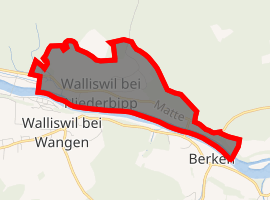Walliswil bei Niederbipp
Walliswil bei Niederbipp is a municipality in the Oberaargau administrative district in the canton of Bern in Switzerland.
Walliswil bei Niederbipp | |
|---|---|
 Coat of arms | |
Location of Walliswil bei Niederbipp 
| |
 Walliswil bei Niederbipp  Walliswil bei Niederbipp | |
| Coordinates: 47°15′N 7°41′E | |
| Country | Switzerland |
| Canton | Bern |
| District | Oberaargau |
| Area | |
| • Total | 1.48 km2 (0.57 sq mi) |
| Elevation | 431 m (1,414 ft) |
| Population (2018-12-31)[2] | |
| • Total | 211 |
| • Density | 140/km2 (370/sq mi) |
| Postal code | 3380 |
| SFOS number | 0990 |
| Surrounded by | Bannwil, Berken, Oberbipp, Walliswil bei Wangen, Wiedlisbach |
| Website | www SFSO statistics |
Geography
Walliswil bei Niederbipp has an area of 1.4 km2 (0.54 sq mi). Of this area, 53.5% is used for agricultural purposes, while 18.8% is forested. Of the rest of the land, 17.4% is settled (buildings or roads) and the remainder (10.4%) is non-productive (rivers, glaciers or mountains).[3]
Demographics
Walliswil bei Niederbipp has a population (as of 31 December 2018) of 211.[4] As of 2007, 1.3% of the population was made up of foreign nationals. Over the last 10 years the population has grown at a rate of 5.7%. Most of the population (as of 2000) speaks German (99.2%), with English being second most common ( 0.4%) and Russian being third ( 0.4%).
In the 2007 election the most popular party was the SVP which received 47.2% of the vote. The next three most popular parties were the SPS (17.4%), the FDP (11.4%) and the CSP (9.1%).
The age distribution of the population (as of 2000) is children and teenagers (0–19 years old) make up 18% of the population, while adults (20–64 years old) make up 61.9% and seniors (over 64 years old) make up 20.1%. In Walliswil bei Niederbipp about 71.9% of the population (between age 25-64) have completed either non-mandatory upper secondary education or additional higher education (either university or a Fachhochschule).
Walliswil bei Niederbipp has an unemployment rate of 1.86%. As of 2005, there were 13 people employed in the primary economic sector and about 4 businesses involved in this sector. 15 people are employed in the secondary sector and there are 1 business in this sector. 36 people are employed in the tertiary sector, with 5 businesses in this sector.[3]
References
- "Arealstatistik Standard - Gemeinden nach 4 Hauptbereichen". Federal Statistical Office. Retrieved 13 January 2019.
- "Ständige Wohnbevölkerung nach Staatsangehörigkeitskategorie Geschlecht und Gemeinde; Provisorische Jahresergebnisse; 2018". Federal Statistical Office. 9 April 2019. Retrieved 11 April 2019.
- Swiss Federal Statistical Office accessed 22-Jul-2009
- Swiss Federal Statistical Office - STAT-TAB, online database – Ständige und nichtständige Wohnbevölkerung nach institutionellen Gliederungen, Geburtsort und Staatsangehörigkeit (in German) accessed 23 September 2019
| Wikimedia Commons has media related to Walliswil bei Niederbipp. |